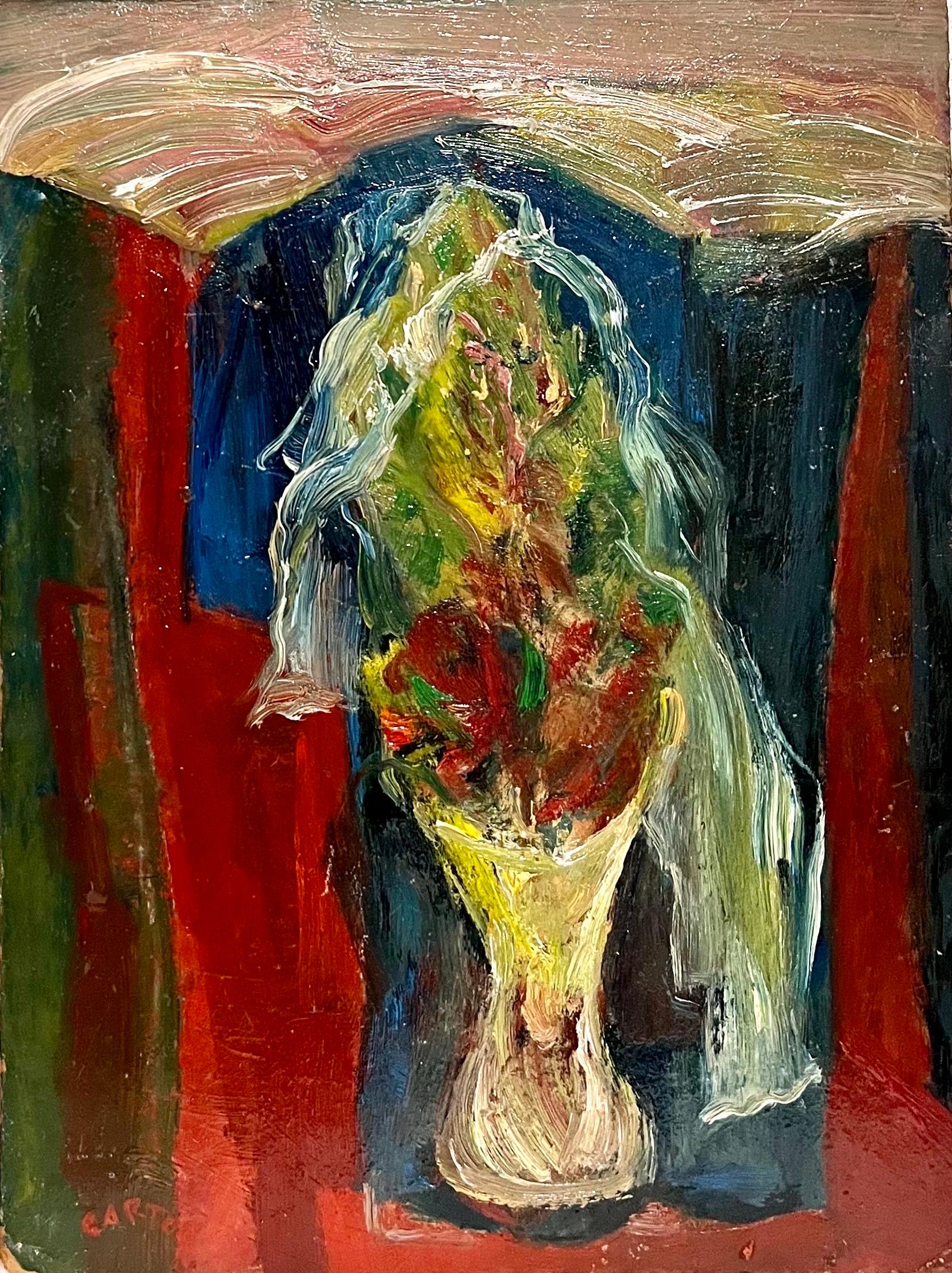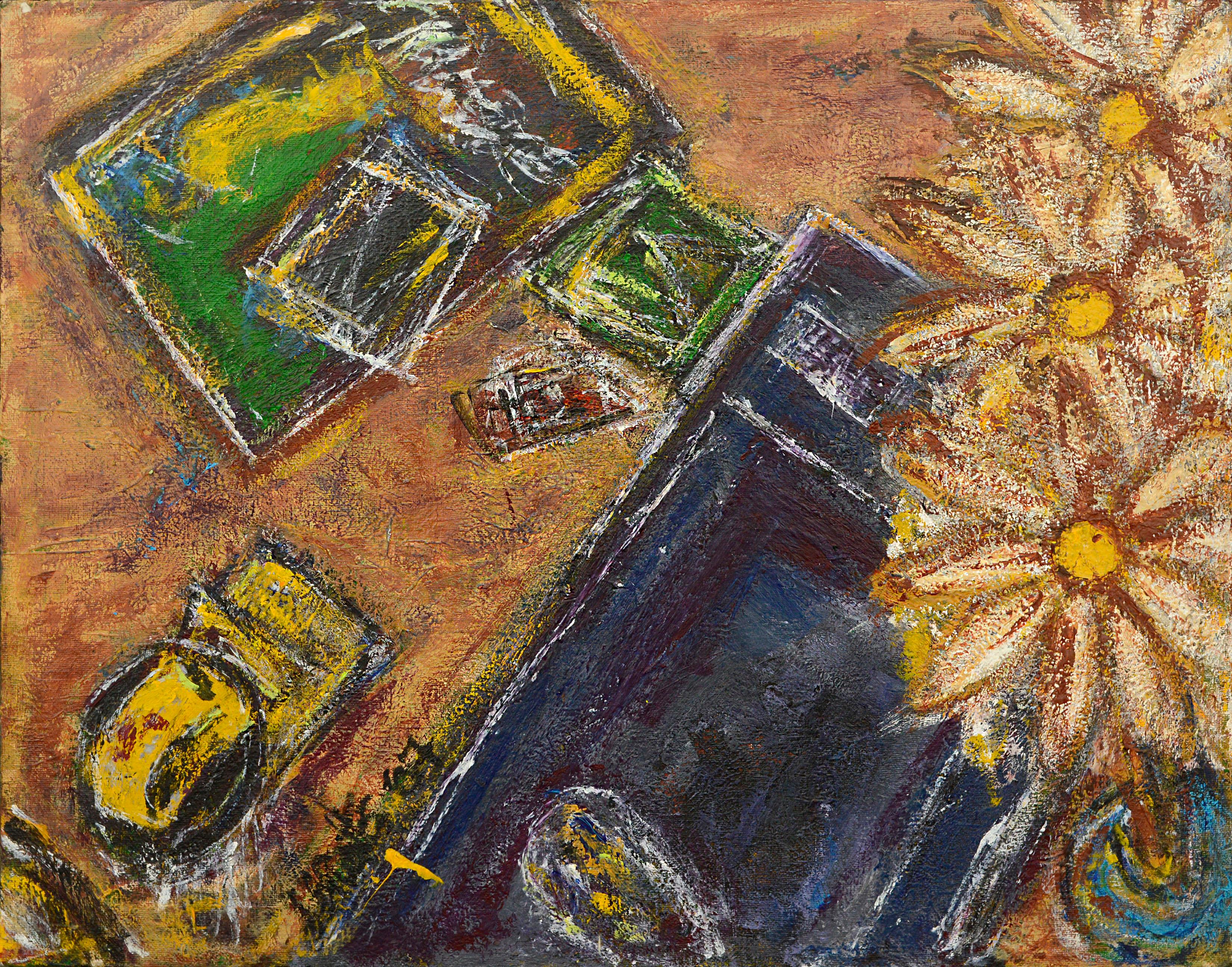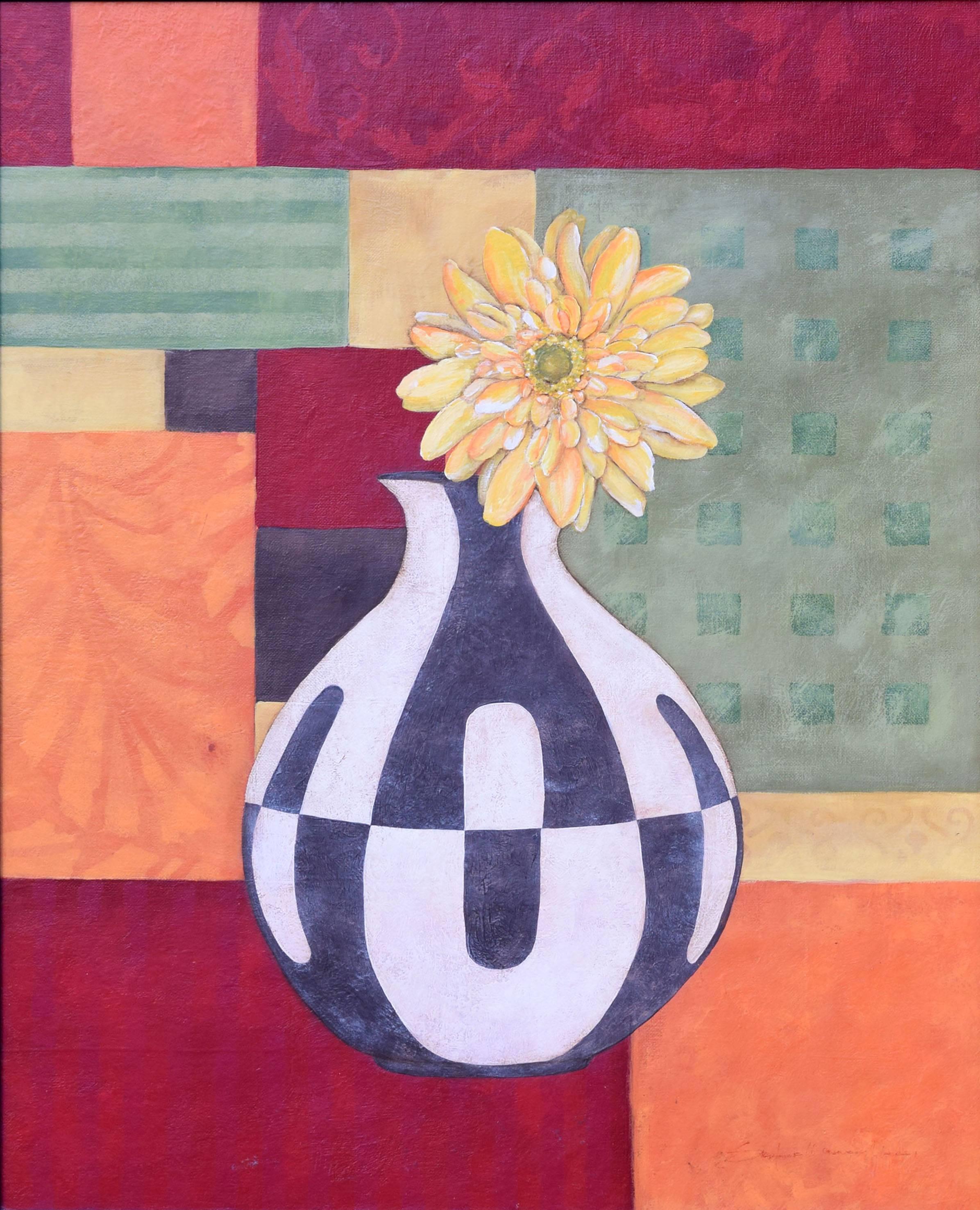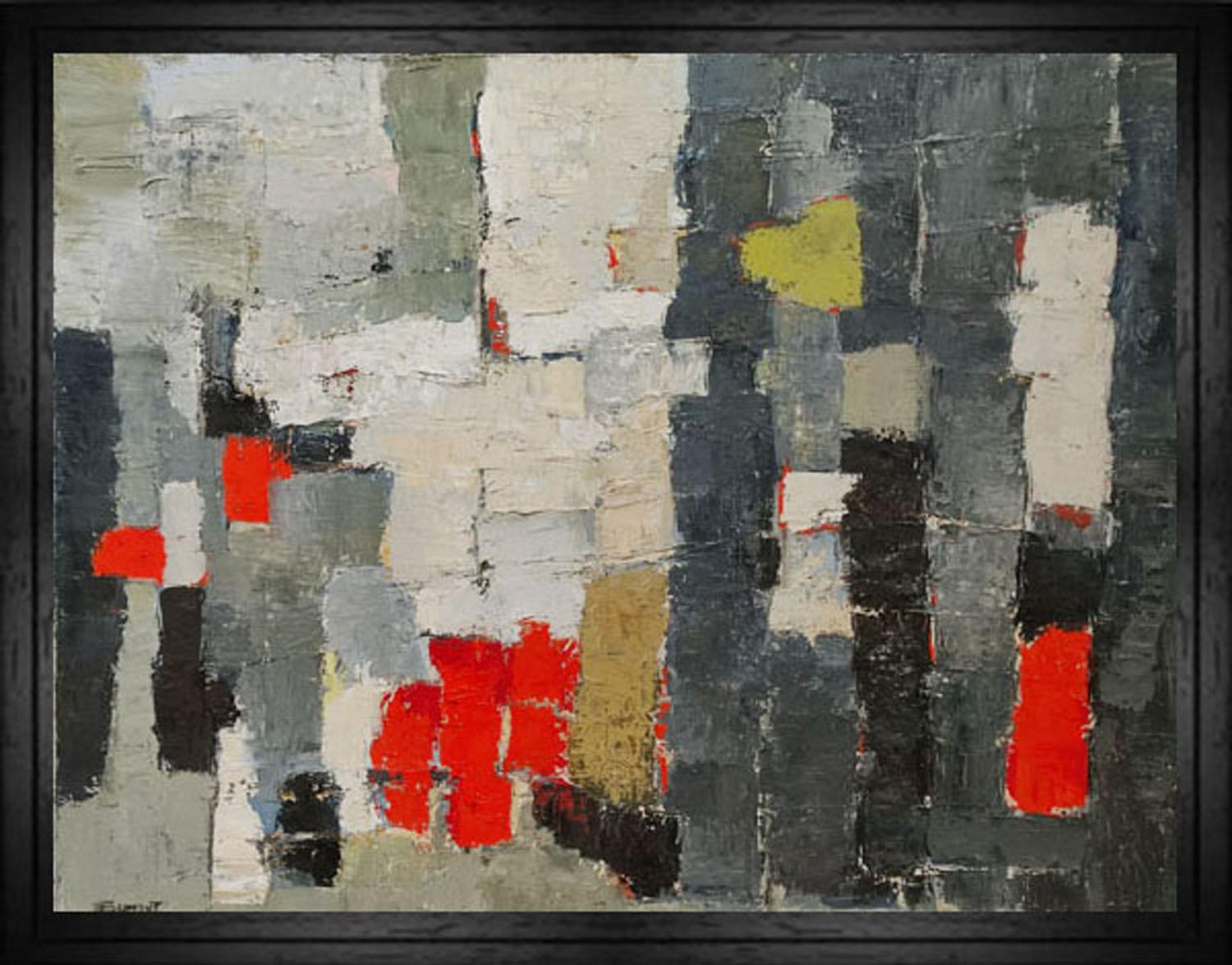Items Similar to "Still Life with Bananas"
Want more images or videos?
Request additional images or videos from the seller
1 of 6
Vaclav Vytlacil"Still Life with Bananas"Dated 1933
Dated 1933
About the Item
Jim’s of Lambertville is proud to offer this artwork by:
Vaclav Vytlacil (1892-1984)
He was born to Czechoslovakian parents in 1892 in New York City. Living in Chicago as a youth, he took classes at the School of the Art Institute of Chicago, returning to New York when he was 20. From 1913 to 1916, he enjoyed a scholarship from the Art Students League, and worked with John C. Johansen (a portraitist whose expressive style resembled that of John Singer Sargent), and Anders Zorn.
He accepted a teaching position at the Minneapolis School of Art in 1916, remaining there until 1921. This enabled him to travel to Europe to study Cézanne’s paintings and works of the Old Masters. He traveled to Paris, Prague, Dresden, Berlin, and Munich seeking the works of Titian, Cranach, Rembrandt, Veronese, and Holbein, which gave him new perspective. Vytlacil studied at the Royal Academy of Art in Munich, settling there in 1921. Fellow students were Ernest Thurn and Worth Ryder, who introduced him to famous abstractionist Hans Hofmann. He worked with Hofmann from about 1922 to 1926, as a student and teaching assistant.
During the summer of 1928, after returning to the United States, Vytlacil gave lectures at the University of California, Berkeley, on modern European art. Soon thereafter, he became a member of the Art Students League faculty. After one year, he returned to Europe and successfully persuaded Hofmann to teach at the League as well. He spent about six years in Europe, studying the works of Matisse, Picasso, and Dufy. In 1935, he returned to New York and became a co-founder of the American Abstract Artists group in 1936. He later had teaching posts at Queens College in New York; the College of Arts and Crafts in Oakland, California; Black Mountain College in North Carolina; and the Art Students League.
His paintings exhibit a clear inclination toward modernism. His still lives and interiors from the 1920s indicate an understanding of the art of Cézanne. In the 1930s, his works displayed two very different kinds of art at the same time. His cityscapes and landscapes combine Cubist-inspired spatial concerns with an expressionistic approach to line and color. Vytlacil also used old wood, metal, cork, and string in constructions, influenced by his friend and former student, Rupert Turnbull. He eventually ceased creating constructions as he considered them too limiting. The spatial challenges of painting were still his preference. During the 1940s and 1950s, his works indicated a sense of spontaneity not felt in his earlier work.
He married Elizabeth Foster in Florence, Italy, in 1927 and they lived and worked in Positano, Italy for extended periods of time. Later on, they divided their time between homes in Sparkill, New York and Chilmark, Massachusetts, where Vyt, as he was affectionately called, taught at the Martha's Vineyard Art Association beginning in 1941. He was associated with the Old Sculpin Group and often exhibited his works in its galleries on the island.
He was honored with solo shows at The Carnegie Institute, Montclair Art Museum, Phillips Memorial Gallery, Krasner Gallery, University of Notre Dame, Rochester Art Gallery, and others.
Vaclav Vytlacil died in 1984 in New York, at age 92.
- Creator:Vaclav Vytlacil (1892-1984, American)
- Creation Year:Dated 1933
- Dimensions:Height: 23 in (58.42 cm)Width: 27 in (68.58 cm)Depth: 2 in (5.08 cm)
- Medium:
- Movement & Style:
- Period:
- Condition:
- Gallery Location:Lambertville, NJ
- Reference Number:
About the Seller
5.0
Vetted Seller
These experienced sellers undergo a comprehensive evaluation by our team of in-house experts.
Established in 1997
1stDibs seller since 2014
36 sales on 1stDibs
Typical response time: 6 hours
- ShippingRetrieving quote...Ships From: Lambertville, NJ
- Return PolicyThis item cannot be returned.
More From This SellerView All
- "Flowers and Fruit"By Mercedes MatterLocated in Lambertville, NJJim’s of Lambertville is proud to offer this artwork by: Mercedes Matter (1913 - 2001) Best known as a painter of abstract still life and founder of the New York Studio School, M...Category
20th Century Abstract Abstract Paintings
MaterialsCanvas, Oil
- "Bottle & Glasses"By James LechayLocated in Lambertville, NJJim’s of Lambertville is proud to offer this artwork by: James Lechay (1907 – 2001) Born in the Bronx in 1907, James Lechay spent most of his childhood in Brooklyn before moving to Joilet, Illinois at age 13 to live with his uncle after his mother passed away. In 1928, he received his B.A. in psychology from the University of Illinois. The next year, he attended one week of graduate school before leaving to study under his brother, the painter Myron Lechay, in New York. At his brother’s studio, James began to associate with other artists of the time such as Milton Avery, Mark Rothko, Arshile Gorky, William Zorach, and Raphael and Moses Soyer. From Myron, James Lechay learned to train his eye to observe natural forms and developed a philosophy dependent upon the relationship built between the artist and the subject. Lechay became engaged in the social and political issues of Depression-era New York and even joined the social realism movement for a brief time in the 1930s. He operated as the leader of the Artists Union while employed by the Works Progress Administration (WPA). With the WPA, Lechay traveled to Las Vegas, New Mexico, where he established a gallery and exhibited the works of Milton Avery, Max Weber, and other WPA artists. Despite his association with many artists and artistic communities in New York in the 1930s and 40s, Lechay opposed adopting a style due to its popularity and commercial success. His use, however, of large brushstrokes from Abstract Expressionism, the flattened plane of Modernism, and the simple compositions of early Abstraction created a combination of styles completely his own. A painter of a vast range of subjects, including still lifes, portraits, and landscapes, Lechay was known to reduce these forms to their visual essentials. Lechay often did not date his paintings as he frequently reworked them, even after they were exhibited, calling his pieces, “finished at all stages and never finished”. In 1945, Lechay was hired by the University of Iowa’s art department, where he worked alongside Mauricio Lasansky, Humbert Albrizio, Carl Fracassini, and Byron Burford...Category
20th Century Abstract Abstract Paintings
MaterialsOil, Canvas
- "Pink Vase with Flowers"By James LechayLocated in Lambertville, NJJim’s of Lambertville is proud to offer this artwork by: James Lechay (1907 – 2001) Born in the Bronx in 1907, James Lechay spent most of his childhood in Brooklyn before moving to Joilet, Illinois at age 13 to live with his uncle after his mother passed away. In 1928, he received his B.A. in psychology from the University of Illinois. The next year, he attended one week of graduate school before leaving to study under his brother, the painter Myron Lechay, in New York. At his brother’s studio, James began to associate with other artists of the time such as Milton Avery, Mark Rothko, Arshile Gorky, William Zorach, and Raphael and Moses Soyer. From Myron, James Lechay learned to train his eye to observe natural forms and developed a philosophy dependent upon the relationship built between the artist and the subject. Lechay became engaged in the social and political issues of Depression-era New York and even joined the social realism movement for a brief time in the 1930s. He operated as the leader of the Artists Union while employed by the Works Progress Administration (WPA). With the WPA, Lechay traveled to Las Vegas, New Mexico, where he established a gallery and exhibited the works of Milton Avery, Max Weber, and other WPA artists. Despite his association with many artists and artistic communities in New York in the 1930s and 40s, Lechay opposed adopting a style due to its popularity and commercial success. His use, however, of large brushstrokes from Abstract Expressionism, the flattened plane of Modernism, and the simple compositions of early Abstraction created a combination of styles completely his own. A painter of a vast range of subjects, including still lifes, portraits, and landscapes, Lechay was known to reduce these forms to their visual essentials. Lechay often did not date his paintings as he frequently reworked them, even after they were exhibited, calling his pieces, “finished at all stages and never finished”. In 1945, Lechay was hired by the University of Iowa’s art department, where he worked alongside Mauricio Lasansky, Humbert Albrizio, Carl Fracassini, and Byron Burford...Category
1990s Abstract Abstract Paintings
MaterialsCanvas, Oil
- "After Work"By Vaclav VytlacilLocated in Lambertville, NJJim’s of Lambertville is proud to offer this artwork. Signed lower right Vaclav Vytlacil (1892-1984) He was born to Czechoslovakian parents in 1892 in New York City. Living in C...Category
20th Century Abstract Expressionist Abstract Paintings
MaterialsBoard, Oil
- “Woman in Black”By Vaclav VytlacilLocated in Lambertville, NJJim’s of Lambertville is proud to offer this artwork by: Vaclav Vytlacil (1892-1984) He was born to Czechoslovakian parents in 1892 in New York City. Living in Chicago as a youth, he took classes at the School of the Art Institute of Chicago, returning to New York when he was 20. From 1913 to 1916, he enjoyed a scholarship from the Art Students League, and worked with John C. Johansen (a portraitist whose expressive style resembled that of John Singer Sargent), and Anders Zorn. He accepted a teaching position at the Minneapolis School of Art in 1916, remaining there until 1921. This enabled him to travel to Europe to study Cézanne’s paintings and works of the Old Masters. He traveled to Paris, Prague, Dresden, Berlin, and Munich seeking the works of Titian, Cranach, Rembrandt, Veronese, and Holbein, which gave him new perspective. Vytlacil studied at the Royal Academy of Art in Munich, settling there in 1921. Fellow students were Ernest Thurn and Worth Ryder, who introduced him to famous abstractionist Hans Hofmann. He worked with Hofmann from about 1922 to 1926, as a student and teaching assistant. During the summer of 1928, after returning to the United States, Vytlacil gave lectures at the University of California, Berkeley, on modern European art. Soon thereafter, he became a member of the Art Students League faculty. After one year, he returned to Europe and successfully persuaded Hofmann to teach at the League as well. He spent about six years in Europe, studying the works of Matisse, Picasso, and Dufy. In 1935, he returned to New York and became a co-founder of the American Abstract Artists group in 1936. He later had teaching posts at Queens College in New York; the College of Arts and Crafts in Oakland, California; Black Mountain College in North Carolina; and the Art Students League. His paintings exhibit a clear inclination toward modernism. His still lives and interiors from the 1920s indicate an understanding of the art of Cézanne. In the 1930s, his works displayed two very different kinds of art at the same time. His cityscapes and landscapes combine Cubist-inspired spatial concerns with an expressionistic approach to line and color. Vytlacil also used old wood, metal, cork, and string in constructions, influenced by his friend and former student, Rupert Turnbull. He eventually ceased creating constructions as he considered them too limiting. The spatial challenges of painting were still his preference. During the 1940s and 1950s, his works indicated a sense of spontaneity not felt in his earlier work. He married Elizabeth Foster in Florence, Italy, in 1927 and they lived and worked in Positano, Italy for extended periods of time. Later on, they divided their time between homes in Sparkill, New York and Chilmark, Massachusetts, where Vyt, as he was affectionately called, taught at the Martha's Vineyard Art...Category
1960s Abstract Expressionist Figurative Paintings
MaterialsOil, Board
- "Blue Fish"By Vaclav VytlacilLocated in Lambertville, NJJim’s of Lambertville is proud to offer this artwork by: Vaclav Vytlacil (1892-1984) He was born to Czechoslovakian parents in 1892 in New York City. Living in Chicago as a youth, he took classes at the School of the Art Institute of Chicago, returning to New York when he was 20. From 1913 to 1916, he enjoyed a scholarship from the Art Students League, and worked with John C. Johansen (a portraitist whose expressive style resembled that of John Singer Sargent), and Anders Zorn. He accepted a teaching position at the Minneapolis School of Art in 1916, remaining there until 1921. This enabled him to travel to Europe to study Cézanne’s paintings and works of the Old Masters. He traveled to Paris, Prague, Dresden, Berlin, and Munich seeking the works of Titian, Cranach, Rembrandt, Veronese, and Holbein, which gave him new perspective. Vytlacil studied at the Royal Academy of Art in Munich, settling there in 1921. Fellow students were Ernest Thurn and Worth Ryder, who introduced him to famous abstractionist Hans Hofmann. He worked with Hofmann from about 1922 to 1926, as a student and teaching assistant. During the summer of 1928, after returning to the United States, Vytlacil gave lectures at the University of California, Berkeley, on modern European art. Soon thereafter, he became a member of the Art Students League faculty. After one year, he returned to Europe and successfully persuaded Hofmann to teach at the League as well. He spent about six years in Europe, studying the works of Matisse, Picasso, and Dufy. In 1935, he returned to New York and became a co-founder of the American Abstract Artists group in 1936. He later had teaching posts at Queens College in New York; the College of Arts and Crafts in Oakland, California; Black Mountain College in North Carolina; and the Art Students League. His paintings exhibit a clear inclination toward modernism. His still lives and interiors from the 1920s indicate an understanding of the art of Cézanne. In the 1930s, his works displayed two very different kinds of art at the same time. His cityscapes and landscapes combine Cubist-inspired spatial concerns with an expressionistic approach to line and color. Vytlacil also used old wood, metal, cork, and string in constructions, influenced by his friend and former student, Rupert Turnbull. He eventually ceased creating constructions as he considered them too limiting. The spatial challenges of painting were still his preference. During the 1940s and 1950s, his works indicated a sense of spontaneity not felt in his earlier work. He married Elizabeth Foster in Florence, Italy, in 1927 and they lived and worked in Positano, Italy for extended periods of time. Later on, they divided their time between homes in Sparkill, New York and Chilmark, Massachusetts, where Vyt, as he was affectionately called, taught at the Martha's Vineyard Art...Category
1960s Abstract Expressionist Abstract Paintings
MaterialsOil, Board
You May Also Like
- Abstract Expressionist Floral ExplosionBy Allie William SkeltonLocated in Soquel, CABright and expressive abstract painting of flowers by Allie Bill Skelton (American, 1942-1986). This piece is unsigned, but was acquired with a collection of other Allie "Bill" Skelton works. Unframed. Image, 12”H x 9”W, oil on artists canvas board. Allie William “Bill” Skelton (American, 1942-1986) was a painter and sculptor active in San Francisco who was involved in the gay art...Category
1980s Abstract Expressionist Abstract Paintings
MaterialsCanvas, Oil, Cardboard
- American Abstract Expressionist Flowers Oil Painting Norman Carton WPA ArtistBy Norman CartonLocated in Surfside, FLNorman Carton (1908 – 1980) was an American artist and educator known for abstract expressionist art. He was born in the Ukraine region of Imperial Russia and moved to the United States in 1922 where he spent most of his adult life. A classically trained portrait and landscape artist, Carton also worked as a drafter, newspaper illustrator, muralist, theater set designer, photographer, and fabric designer and spent most of his mature life as an art educator. Carton showed in and continues to be shown in many solo and group exhibitions. His work is included in numerous museums and private collections throughout the world. Norman Carton was born in the Dnieper Ukraine territory of the Russian Empire in 1908. Escaping the turbulence of civil war massacres, he settled in Philadelphia in 1922 after years of constant flight. While attending the Pennsylvania Museum School of Industrial Art, Carton worked as a newspaper artist for the Philadelphia Record from 1928 to 1930 in the company of other illustrator/artists who had founded the Ashcan School, the beginnings of modern American art. From 1930 to 1935, he studied at the Pennsylvania Academy of Fine Arts under Henry McCarter, who was a pupil of Toulouse-Lautrec, Puvis de Chavanne, and Thomas Eakins. Arthur Carles, especially with his sense of color, and the architect John Harbison also provided tutelage and inspiration. Following his time at the Pennsylvania Academy of Fine Arts, Carton studied at the Barnes Foundation from 1935 to 1936 where he was influenced by an intellectual climate led by visiting lecturers John Dewey and Bertrand Russell as well as daily access to Albert C. Barnes and his art collection. Carton was awarded the Cresson Traveling Scholarship in 1934 which allowed him to travel through Europe and study in Paris. There he expanded his artistic horizons with influences stemming from Henri Matisse, Pablo Picasso, Chaim Soutine, and Wassily Kandinsky. While at the Pennsylvania Academy of Fine Arts, Carton was also awarded the Toppan Prize for figure painting as well as the Thouron Composition Prize. He received numerous commissions as a portrait artist, social realist, sculptor, and theatrical stage designer as well as academic scholarships. During this time, Carton worked as a scenery designer at Sparks Scenic Studios, a drafter at the Philadelphia Enameling Works, and a fine art lithographer. From 1939 to 1942, the Works Progress Administration (WPA) Federal Art Project employed Carton as a muralist and easel artist. He collaborated with architect George Howe. The WPA commissioned Carton to paint major murals at the Helen Fleischer Vocational School for Girls in Philadelphia, the Officers’ Club at Camp Meade Army Base in Maryland, and in the city of Hidalgo, Mexico. Throughout the 1940s, Carton exhibited and won prizes for his semi-abstract Expressionist and Surrealist paintings. He socialized with and was inspired by Émile Gauguin and Fernand Leger. During World War II, Carton was a naval structural designer and draftsman at the Cramps...Category
Mid-20th Century Abstract Expressionist Still-life Paintings
MaterialsOil, Board
- Three Daisies Abstracted Still-LifeBy Daniel David FuentesLocated in Soquel, CAWhimsical abstracted textural still life with three daises and other objects floating through an ambiguous orange space by Daniel David Fuentes (American, 1978-2016). From a collecti...Category
Early 2000s Abstract Expressionist Abstract Paintings
MaterialsCanvas, Oil, Cardboard
- Mid-Century Modern Abstract Expressionist Still Life Oil PaintingBy Toma YovanovichLocated in Buffalo, NYAn original mid century modern abstract expressionist painting by American artist Toma Yovanovich. Toma Yovanovich (1931-2016) Yovanovich was a painter/printmaker whose work i...Category
1960s Abstract Expressionist Abstract Paintings
MaterialsIllustration Board, Oil
- Abstract Floral with Art Deco VaseBy Stephanie MarrottLocated in Soquel, CAAbstract Floral painting with geometric vase by Stephanie Marrott (American, 20th Century). Original acrylic on artists board. Signed lower right "Stephanie Workman Marrott" in pen. ...Category
Late 20th Century Abstract Expressionist Still-life Paintings
MaterialsCanvas, Acrylic, Cardboard
- dynamic, abstract painting, oil on canvas, expressionism, texture, french artistBy SOPHIE DUMONTLocated in LANGRUNE-SUR-MER, FRSophie DUMONT's abstract is not a concept, it is an approach where each canvas is built around graphics put into perspective by color. The drawing can recall the shape of a body or ...Category
21st Century and Contemporary Abstract Expressionist Abstract Paintings
MaterialsOil
Recently Viewed
View AllMore Ways To Browse
Vineyard Art
Banana Used
Banana Art
Vintage Banana
Bananas And Art
Banana Artwork
California Vineyards Art
Matisse 1930
Picasso 1933
Abstract Paintings Of Notre Dame
Vintage Cork Art
Banana Frame
Vintage Frames Notre Dame
1940s Cubist Abstract Painting
American School Cubist Abstract
Cezanne Style Still Life
Abstract Paris Cityscape
California Vineyards Oil Painting




